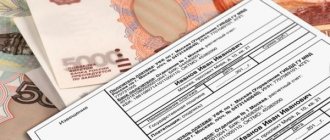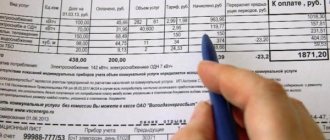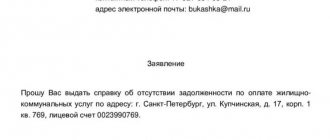The basic principles for drawing up tax bills are in Appendix 1 to Bank of Russia Regulation No. 383-P dated June 19, 2012 and in Appendix 2 to Order of the Russian Ministry of Finance dated November 12, 2013 No. 107n (as amended on September 14, 2020).
From January 1, 2021, the Federal Tax Service switched to a treasury system for servicing payments to budgets. Because of this, the details for fields 13, 14, 15 and 17 of the payment order have changed. Now they will indicate the data of the treasury account and updated data of the recipient's bank. Each tax has its own BCC, which serves as one of the main tax identifiers. In addition, the type of tax and tax period are also specified in the purpose of the payment. For example, “2021 Property Tax.”
Payment order fields
The payment order has special fields. Each separate field with its own unique number.
Generate receipts for paying taxes directly in Externa! We give you 14 days!
Try for free
Characteristics of the main significant fields
In 2021, a number of changes will occur in the order in which payment order fields are filled out. The new rules were approved by the Ministry of Finance by Order No. 199N dated September 14, 2020. Some of them are valid from January 1, and some only from October 1, 2021.
Field number 5 will tell you about the type of payment: “urgent”, “mail”, “telegraph”. Fill it out in the manner prescribed by the bank. If there is no such order, leave the field blank.
In fields No. 8-11, enter your data: name of the organization or full name of the individual, account number, name and location of the bank, BIC and account number.
Field No. 16. An important field that includes the name of the recipient. When transferring the tax, you need to indicate the name of the Federal Tax Service and the short name of the Federal Treasury body. Fields No. 12, 13, 14 and 17 are used to indicate the recipient's details. Please note that as of January 1, 2021, the details have changed. We'll tell you how to recognize them below.
Field No. 18. This is the transaction type code. When making a tax payment, you should use code “01”.
Field No. 21. It is very important to know the order of tax payments in the payment order. It is in this field that this information is indicated (Article 855 of the Civil Code of the Russian Federation). The fifth priority is established for all taxes.
Field No. 22. The UIP code is noted here. Most often it is equal to “0”. If the Federal Tax Service has noted the UIP in the tax request, then it must be written down in the payment slip.
Field number 24 . Here enter information about the payment to identify it: name of the tax, period and basis for payment. For example, “⅓ VAT for the 1st quarter of 2021.”
Field number 101 . This field records the payer status. For paying taxes from organizations this status is “01”, for individual entrepreneurs it is “09”. Only for personal income tax in both cases it is equal to “02”, since in this case the payer is a tax agent. Please note that from October 1, 2021, the code “09” will no longer be valid; instead, individual entrepreneurs will indicate the code “13”.
Field No. 104. This is where you need to write down the BCC. It is very important not to make mistakes in the numbers, because inaccuracies in the BCC can lead to the payment being stuck or being assigned to another type of payment.
Field No. 105 contains the OKTMO code.
Field No. 106 will tell the bank about the basis for the payment (clause 7 of Appendix No. 2 to Order of the Ministry of Finance of the Russian Federation dated November 12, 2013 No. 107N). Now we indicate in it the code “TP” for current payments, “TR” for payments on claims, “AP” for a tax audit report, etc. From October 1, 2021, instead of the codes “TR”, “AP”, “PR” and “AR” it will be necessary to indicate the code “ZD” - repayment of debt for expired periods, including voluntary.
Field No. 107. It indicates the period for which a particular tax is paid.
Field No. 108. Filled in when paying a debt or a tax fine as required. It indicates the number of the foundation document; if there is no such document, simply put “0”. Despite the fact that the “TP” code and others will be canceled, they will continue to appear in this field. For example, for payment on request for tax payment No. 123, the field will be filled in as “TR0000000000123”.
Field No. 109. If the tax is paid on the basis of a declaration, the date of its signing should be indicated (clause 10 of Appendix No. 2 to Order of the Ministry of Finance of the Russian Federation dated November 12, 2013 No. 107N). If there is no date, a zero is entered.
Field No. 110 is not filled in.
What is a receipt for a cash receipt order?
The cash receipt receipt is the primary document confirming the fact that the cashier has received money from the depositor, for example, a buyer, employee, founder (participant, owner).
The order itself and the receipt for the cash receipt order form have a common form (the receipt is a detachable part of the KO-1 form document). The (unified) form of the order itself, as well as the receipt for the cash receipt order, was approved by Resolution of the State Statistics Committee of August 18, 1998 No. 88 (hereinafter referred to as Resolution No. 88). And although since 2013, unified forms of primary documents have ceased to be mandatory for use, the use of unified forms for cash documents, in particular form 0310001, continues to remain relevant (directive of the Bank of Russia dated March 11, 2014 No. 3210-U).
To learn about what documents are considered cash registers and what are the features of their execution, read the material “Nuances of documenting cash transactions.”
ConsultantPlus experts spoke in detail about the nuances of registering cash transactions. If you do not have access to the K+ system, get a trial online access for free.
Where to get details for payment orders in 2021
Due to the transition to the treasury account servicing system, the details of payment orders have changed. New details are valid from January 1, 2021. To facilitate the transition and avoid a large number of unclear payments, the Federal Tax Service allowed the use of old details until April 30. But we recommend not to delay and immediately use the new instructions, since many banks no longer accept payments filled in with old data.
Each region has its own details - there are 85 of them in total. The Federal Tax Service provided information about the details in the table, which is given in the letter dated 10/08/2020 No. KCH-4-8 / [email protected] For example, Moscow indicates the following data:
- Field 13 “Name of the recipient's bank” - GU BANK OF RUSSIA FOR THE Central Federal District//UFK FOR MOSCOW, Moscow;
- Field 14 “BIC of the recipient’s bank” - 004525988;
- Field 15 “Recipient bank account number” - 40102810545370000003;
- Field 17 “Treasury account number” - 03100643000000017300.
Exceptions for non-cash payments
The bank accepts payments in cash when the person presents an identification document. As an exception, there are bills whose total amount is less than 30 thousand rubles:
- Calculations with budgets by organizations of all levels;
- Payment for government services;
- Payment for housing (utilities, security, etc.);
- Payment of membership fees and alimony.
A receipt in the PD-4sb format is used to credit a sum of money to the state budget. For other cases, receipt PD-4 is used with the same requirements regarding filling out, but it will not include data on budget-type organizations.
How to find out the document index for tax payment
The Federal Tax Service may write such an index in the tax payment request for legal entities. And for individuals, the document index is present in the receipt (notification) of accrued taxes. If an individual does not receive such notifications, then you can find out the document index and print a receipt in your personal account on the Federal Tax Service website.
If you are transferring a current payment, arrears not at the request of the inspection, or the UIN is simply not indicated in the request, leave field 22 empty.
You can see how to correctly draw up a payment order using an example. The sample shows a payment slip for the transfer of personal income tax for March 2021. The personal income tax amount is 17,144 rubles. The drafter of the document and tax agent is LLC “White Bear”.
filling out a payment order
payment order for income tax (federal budget)
Filling out a receipt form PD-4
The receipt form PD-4 is filled out manually using a regular fountain pen or online, and then printed. This approach will help you save time and come to a SberBank branch with a ready-made document for payment. Payment will be accepted if the details are correct and the completed receipt meets the stated requirements. In the “Payment purpose” field, you can additionally enter data if it is required to determine the payment.
A separate form is provided for each tax or invoice. The form of the banking document is unified and approved by SberBank of the Russian Federation and the Ministry of Taxes. The receipt must include information about the organization that receives the payment:
- Full name with details;
- Municipality code;
- Payment Description;
- Budget classification.
Information about the person making the payment must also be present:
- Full name (without abbreviations);
- Identification and tax number;
- Mailing address;
- The amount of money displayed in rubles and kopecks.
Receipt samples
Samples of standard receipts to Sberbank
. Some other banks also accept such receipts, but may charge additional fees.
Tax
Form N PD-4 sb (tax) is filled out for registration through a branch of Sberbank of the Russian Federation of any types of payments to the budget through Sberbank of Russia. state fees, international passports, traffic police fines, MosEnergoSbyt, housing and communal services (utilities), passports, to court, Russian Post, to the registry office, insurance premiums
Form: 27 kb sample EXCEL.
Form: 96 kb sample WORD.
Link nalog.ru: Filling out a payment document (receipt PD-4 sb) for the transfer of taxes, fees and other payments to the budget system of the Russian Federation
receipt for payment of international passport (state duty).doc 55 kb sample WORD.
1. State duty for issuing a foreign passport (old). (Total payable: 1000 rubles). 2. State duty for issuing a foreign passport (new) containing an electronic storage medium. (Total payable: 2500 rubles). 3. State duty for obtaining a foreign passport for a child under 14 years of age. (Total payable: 1200 (new) and 300 (old) rubles).
See also: Sample application form for a foreign passport
receipt for payment of a passport (ordinary) of the Russian Federation (state duty) 55 kb sample WORD.
For registration of a passport (ordinary) citizen of the Russian Federation, the state fee is 200 rubles. Replacement or loss - also 200 rubles.
See also: How to obtain a Russian passport.
Online service: Receipt for payment of a fine from the State Traffic Safety Inspectorate of the Ministry of Internal Affairs of Russia, you can also generate receipts there for a Driver's license and technical inspection
Since 2011, when fines are issued at Sberbank branches, they usually charge a commission, usually 15 rubles per receipt.
MosEnergoSbyt receipt (for payment of electricity).xls 3.5 MB sample EXCEL.
Receipt for insurance contributions to the pension fund and health insurance.xls 43 kb sample EXCEL.
receipt for payment of state duty registration of individual entrepreneur.doc 96 kb sample WORD.
See also: Registration of individual entrepreneurs step by step
Not tax
Form N PD-4 (not tax) is filled out for processing through a branch of Sberbank of the Russian Federation any payments for any services (except for payments to the budget and insurance contributions). For example, to pay for goods or services.
Form: 29 kb sample EXCEL.
Fill out only the first part, the second will be filled in automatically in Excel.
Form: 80 kb sample WORD.
Blank Sberbank receipt form
Sample: 80 kb sample WORD.
How to read housing and communal services receipts and understand them? Instructions
Who generates receipts for housing and communal services payments?
A receipt for payment of housing and communal services is an official payment document that contains information about the amount of debts of consumers for past billing periods to housing companies providing various services.
Most often, the owner receives several “payments” from different suppliers. Some receipts are generated by utility service providers themselves, for example, payment documents for gas and electricity. To do this, it is enough for the owner of the apartment to submit the testimony. But sometimes the management company or homeowners association enters into contracts with companies directly and calculates all payments itself, and then transfers the money to suppliers.
Different management companies and homeowners associations have different procedures for generating payment documents. Some management organizations send data on utility payments in one receipt. In other cases, residents transmit meter readings for electricity, hot and cold water to the chairman of the HOA, and send data from the gas meter directly to the supplier.
What does a utility bill look like?
In order not to overpay for utilities, each owner needs to know what information is indicated in the payment document. First, examine the top of the receipt. It contains the name of the organization presenting the invoice, the name of the service, bank details, as well as your full name, address and individual client number, which does not change. The following is the amount you must pay. There is also a QR code in the upper right corner. If you scan it with your smartphone, you can go to the supplier's website and make a payment. Just below there is information about the current tariff, the last transmitted readings and the meter number. Pay attention to the data on the area of the premises and the number of people living in the apartment. Check carefully that all data matches.
At the bottom of the receipt there is contact information for the supplier: postal address, contact phone numbers for the operations center, as well as information about visiting days and hours of operation. If you notice an error or inaccuracy in the payment document, please contact the operation center specialists at the indicated telephone numbers so that they can recalculate.
What is the difference between housing and communal services and housing and communal services?
Housing and communal services are a system that ensures the life of the population and the uninterrupted operation of enterprises. The sphere is regulated by federal and municipal authorities. The main function of housing and communal services organizations is to provide people with quality services.
Housing and communal services are services for supplying consumers with resources: electricity, heat, cold and hot water, gas and others. This also includes garbage removal, keeping entrances and local areas clean and tidy, as well as landscaping urban areas in accordance with established regulations and standards.
What is included in the rent? How is its amount calculated?
The rent includes utilities that the homeowner receives - heating, electricity, gas, maintenance of common property, major repairs, as well as garbage removal and cleaning of the local area. Every month, apartment owners receive several types of payment receipts.
Each region has its own tariff amount for each individual utility service. The more you spend the resources provided, the more you will have to pay for it. The amount of rent for an apartment also depends on the number of residents, the size of the premises and the availability of meters. Pay attention to whether your metering devices are working properly, so that it does not later turn out that you underpaid or overpaid.
What are included in utilities when renting an apartment?
Utilities for rental housing include the same payments for the resources received. The only difference is how you want to negotiate with the apartment tenant. If you want to rent out an apartment, then before looking for a tenant, decide whether you want him to pay utilities. You can immediately include the approximate amount of rent in the monthly rent price or constantly calculate it based on received payment receipts. Or you can oblige the tenant to regularly submit testimony and pay utility bills on their own.
Legal regulation of the issue
Issues of housing and communal services are regulated by several legal acts. You can rely on them if you suddenly fail to resolve a dispute with the management organization or utility providers without court. In addition, the regulations specify the rights and obligations of owners.
You can protect yourself with the help of the Federal Law “On the Protection of Consumer Rights” of February 7, 1992 No. 2300–1 and find the necessary conclusions in Resolution No. 22 of the Supreme Court of the Russian Federation. The latest legislative act contains information on how to resolve procedural issues and how payments for housing and utilities are determined. And from Article 155 of the Housing Code of the Russian Federation “Payment of payment for residential premises and utilities” you can find out how penalties are calculated for late payment of utility bills.
According to the law, in the event of a dispute, the parties can reach an agreement without involving other participants. But, if a truce cannot be reached, the city or district administration can be involved. If suddenly the authorities did not help you, then contact the supervisory authorities - IGZHN of the Perm Territory or the prosecutor's office.
Explanation of abbreviations on the receipt
- PU , IPU - metering device, individual metering device. This refers to a meter for cold or hot water, gas and other utilities.
- USZN - Department of Social Protection of the Population. You can contact us here if you want to apply for a subsidy or apply for benefits.
- registered/stayed — the number of people registered in the apartment and those who currently live in it.
- general name - common property. This includes stairwells, elevators, basements and other premises that are not parts of apartments.
- ODN - general house needs.
- housing maintenance - maintenance of housing stock.
- ITU - individual accounting point.
- ODPU is a common house metering device.
- KTU - collective metering point.
- MOP - public places.
- SOI - maintenance of common property.
- AD - agency agreement.
- DHW , cold water supply - hot water supply, cold water supply.
- kW*h - kilowatt-hour.
- E/E - electricity.
- MSW —solid municipal waste.
Photo: 1MI, Properm.ru
Convenient service for downloading the necessary forms
PD-4 receipts are available on our website. You can fill out the document according to the available template. You can download it to your computer in several formats. Use the provided search to find the required document. To receive qualified assistance, contact our specialist.
If you have not found the answer to your question or there are still misunderstandings, contact a lawyer for a free consultation in the chat on our website
| Receipt form PD-4 SberBank |
| Receipt form PD-4SB tax |
Who can issue receipts for payment of services?
According to such regulations as 290-FZ and 54-FZ, the following are authorized to issue such receipts:
- legal entities and individual entrepreneurs;
- organizations taxed on a patent basis;
- legal entities and individual entrepreneurs whose place of business is located in remote places, and also due to its type, which does not allow issuing checks;
- some UTII payers.
Among payers, UTII has the right to issue receipts for the provision of services such as:
- veterinary;
- household;
- indoor catering up to 150 m2 or without halls;
- rental of premises for sales and catering;
- retail trade without sales rooms or in premises up to 150 m2;
- hotels with an area of up to 500 m2;
- parking;
- Service stations and car washes;
- cargo transportation;
- transportation of people;
- outdoor advertising.
Thus, receipts are issued by enterprises that provide field services or are unable to purchase a cash register and register it.
Important! When providing legal services, they issue either a receipt with a cashier's check, or an agreement-invoice for payment at the bank, but without a receipt. Without other documents confirming payment, it is authorized to be issued by a lawyer working independently and without registering as a legal entity.
Types of payments
Types of payments from individuals accepted by SberBank:
- payments credited to the budget (personal income tax, simplified tax system, UTII, etc.) and extra-budgetary funds (pension, medical insurance, social insurance);
- payments for provided housing and communal services (housing and communal services, gas, electricity, water supply);
- payments for other paid services provided (Internet, TV, services, etc.);
- payments for goods (via an online store, a store by order);
- insurance payments (pension, medical insurance, social insurance);
- voluntary contributions (voluntary pension insurance, charity);
- payments in favor of individuals carrying out entrepreneurial activities without forming a legal entity (IP);
- payments for the purchase of real estate, contributions to the accounts of housing, housing construction, garage and other cooperatives (organizations), except for rent and utility bills;
- payments received from refugees, internally displaced persons and other categories of the population to repay long-term interest-free repayable loans;
- contributions accepted from individuals in favor of the Non-State Pension Fund of Sberbank;
- other payments (housing and communal services receipt, utilities, court receipt, Russian Post receipt, registry office receipt, income tax receipt).
Sample of filling out a receipt for the PKO
The cashier, when receiving the PKO, must recalculate the amount received and check the correctness of the specified details. The detachable part of the PQS should contain data about the contributor, the amount contributed, the basis, number and date of the PQS. Many specialized programs and services allow you to fill out a cash receipt order online, and information from the main part is automatically transferred to the detachable part.
BSO form for providing services to the public
The letter of the State Tax Service of Russia dated March 31, 1998 No. VK-6-16/210 contains the procedure for filling out strict reporting forms for all types of household services. Whether services belong specifically to household or other services is determined according to the service classifier (OKUN).
When providing household services, strict reporting forms from BO-1 to BO-14 are used. Each form has some filling features. So, for example, if an entrepreneur provides services for sewing or major repairs of clothing, then the BO-4 form is used. The form is filled out in duplicate using carbon copies.
If an entrepreneur rents out items, then the BO-6 form is used - an obligation-receipt. A receipt form for payment for services is filled out in 2 copies (the first is kept until the rental items are returned, and the second is given to the client).
The form is filled out by the receiver in clear, legible handwriting; no corrections to the form are allowed. A damaged or incorrectly completed document form is crossed out and attached to the document form accounting book for the day on which it was issued.
Records of document forms produced in the printing house are kept in a special form book according to their names, series and numbers. The sheets of such a book are numbered, laced and signed by the head and accountant of the company or individual entrepreneur, and also, if available, sealed.
It is necessary to remember the shelf life of the forms: they are stored for at least five years. To store BSOs (copies of forms, forms’ counterfoils) must be packed in specially sealed bags. When the storage period for the forms ends (but not earlier than a month has passed since the date of the last inventory), these documents are written off on the basis of an act of destruction (the document is drawn up by a commission formed by the head of the company).
Receipt for payment for services (sample):
Attention! Payment is made after submitting the request!
In the form of a paper document
Extract on the date of receipt by the rights registration authority of the application for state cadastral registration and (or) state registration of rights and documents attached thereto 1270 RUR Extract from the Unified State Register of Real Estate on registered agreements for participation in shared construction 3420 RUR
Extract from the Unified State Register of Real Estate on the transfer of rights to a property 1270
Extract from the Unified State Register of Real Estate on the rights of an individual to the real estate he/she has (available) on the territory of 1 subject of the Russian Federation (for legal entities) 2080
Extract from the Unified State Register of Real Estate on the rights of an individual person who owns real estate in the territory of more than 57 constituent entities of the Russian Federation (for legal entities) 3480 rub.
Extract from the Unified State Register of Real Estate on the rights of an individual to his/her real estate properties in the territory of 2 to 28 constituent entities of the Russian Federation (for legal entities) 2900 rub.
Extract from the Unified State Register of Real Estate on the rights of an individual and real estate properties he/she has in the territory from 29 to 56 constituent entities of the Russian Federation (for legal entities) RUR 3,240
Extract from the Unified State Register of Real Estate (for legal entities) RUR 2,550
Extract from the Unified State Register of Real Estate on the main characteristics and registered rights to the property (for legal entities) RUB 1,270
Extract on the border between the constituent entities of the Russian Federation, the border of a municipal entity and the border of a populated area (for legal entities) 5220 rub.
Extract on a zone with special conditions for the use of territories, territorial zone, public easement, territory of a cultural heritage site, territory of rapid socio-economic development, zone of territorial development in the Russian Federation, gambling zone, forestry, specially protected natural area, special economic zone, hunting ground , Baikal natural territory and its ecological zones, coastline (border of a water body), territory surveying project (for legal entities) 5220 rub.
Extract on the contents of title documents (for legal entities) RUB 1,930
Cadastral plan of the territory (for legal entities) 5220 RUR
A copy of an agreement or other document expressing the content of a unilateral transaction, completed in simple written form, contained in the registry file (except for an enterprise as a property complex) (for legal entities) 1080 rub.
A copy of an agreement or other document expressing the content of a unilateral transaction with an enterprise, completed in simple written form, contained in the registry file for an enterprise as a property complex (for legal entities) RUB 1,590
A copy of the document on the basis of which information about the territory of the cadastral quarter (territory within the cadastral quarter), territorial zone, public easement, zone with special conditions for the use of the territory, territory of a cultural heritage site (for legal entities) is entered into the Unified State Register of Real Estate (for legal entities) 5220 RUR
A copy of another document on the basis of which information about the property was entered into the Unified State Register of Real Estate (for legal entities) RUB 1,270
A copy of the boundary plan, technical plan, permission to put the facility into operation (for legal entities) 5220 rub.
Certificate of persons who received information about real estate objects (for legal entities) 1270 rub.
In the form of an electronic document
Extract on the date of receipt by the rights registration authority of the application for state cadastral registration and (or) state registration of rights and documents attached thereto (820 rubles)
Extract from the Unified State Register of registered agreements of participation in shared construction (1630 rubles)
Extract from the Unified State Register of Real Estate on the transfer of rights to a property (580 rubles)
Extract from the Unified State Register of Real Estate on the rights of an individual to the real estate he/she owned (available) in the territory of 1 constituent entity of the Russian Federation (RUB 760)
Extract from the Unified State Register of Real Estate on the rights of an individual to the real estate he/she owns in the territory of more than 57 constituent entities of the Russian Federation (RUB 1,280)
Extract from the Unified State Register of Real Estate on the rights of an individual to the real estate properties he/she has in the territory from 2 to 28 constituent entities of the Russian Federation (990 rubles)
Extract from the Unified State Register of Real Estate on the rights of an individual to the real estate properties he/she has in the territory from 29 to 56 constituent entities of the Russian Federation (RUB 1,160)
Extract from the Unified State Register of Real Estate about the property (RUB 700)
Extract from the Unified State Register of Real Estate on the main characteristics and registered rights to the property (RUB 820)
Extract on the border between the constituent entities of the Russian Federation, the border of a municipal entity and the border of a populated area (700 rubles)
Extract on a zone with special conditions for the use of territories, territorial zone, public easement, territory of a cultural heritage site, territory of rapid socio-economic development, zone of territorial development in the Russian Federation, gambling zone, forestry, specially protected natural area, special economic zone, hunting ground , Baikal natural territory and its ecological zones, coastline (border of a water body), territory surveying project (700 rubles)
Extract on the contents of title documents (900 rubles)
Cadastral plan of the territory (RUB 700)
A copy of an agreement or other document expressing the content of a unilateral transaction, completed in simple written form, contained in the registry file (except for an enterprise as a property complex) (450 rubles)
A copy of an agreement or other document expressing the content of a unilateral transaction with an enterprise, completed in simple written form, contained in the registry file for the enterprise as a property complex (560 rubles)
A copy of the document on the basis of which information about the territory of the cadastral quarter (territory within the cadastral quarter), territorial zone, public easement, zone with special conditions for the use of the territory, territory of a cultural heritage site (RUB 1,110) is entered into the Unified State Register of Real Estate.
A copy of another document on the basis of which information about the property was entered into the Unified State Register of Real Estate (RUB 530)
A copy of the boundary plan, technical plan, permission to put the facility into operation (RUB 1,110)
Certificate of persons who received information about real estate objects (RUB 820)









